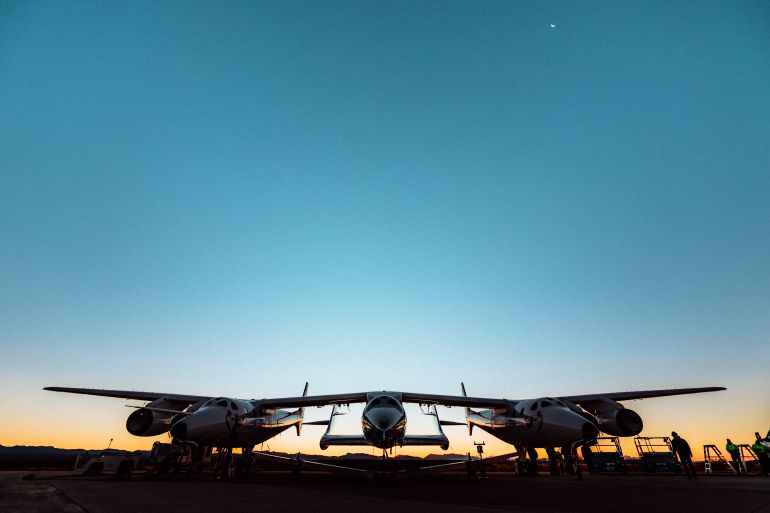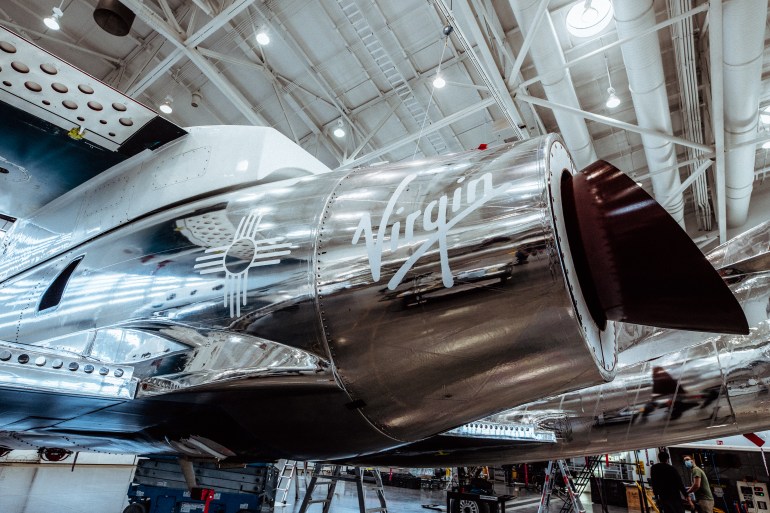Virgin Galactic eyes expansion despite launch delay
As Virgin Galactic works to solve the interference issues that grounded its most recent test flight, Richard Branson’s space tourism company is developing new versions of its passenger spacecraft to support hundreds of flights and additional spaceports.

Virgin Galactic is poised to roll out SpaceShip III this week, one of two new classes of launch vehicle it is developing to support its long-term goal for multiple spaceports, even as its latest test launch remains delayed and its earnings took a hit last year.
Billionaire Richard Branson’s space company said last month it plans to begin ferrying private, paying passengers into space by early 2022, but it reported a net loss of $74m during the fourth quarter and acknowledged its February test flight, which was already a redo of a December launch, faced a months-long delay.
Keep reading
list of 4 itemsSpace wine: Researchers analyse wine that spent year on ISS
Fly me to the moon: Three men to pay $55m each for SpaceX flight
Billionaire raffling off SpaceX flight to fund cancer research
Still, Virgin Galactic stands by its ambitious agenda. The firm will introduce SpaceShip III on Tuesday and has also started work on its new workhorse Delta class of spaceships, which “will really accelerate the economic growth of the company,” Virgin Galactic’s Chief Executive Officer Michael Colglazier said during a February 25 earnings call.
But Colglazier also told investors the company’s latest test flight will likely be in May, and said “We’re not going to place specific dates around our second and third test flights. We expect them both to occur this summer.” Further delays could tighten the timeline for welcoming paying space tourists aboard early next year.
Fixing interference
The delay in the latest test was necessary to fix the underlying source of electromagnetic interference (EMI) that caused the rocket motor computer to lose connection with the rocket motor, cutting short a December 12 test flight. SpaceShipTwo Unity returned safely to the spaceport.
The interference was linked to a new, upgraded flight computer system, Mike Moses, Virgin Galactic’s president of space missions and safety, said on the earnings call.
The firm made modifications to address that interference only to discover just before the February test flight that the changes had created other problems, Moses explained.
“It became apparent that those changes that we had made to address EMI had unintentionally created additional noise within our sensory environment,” Moses said.
That noise could potentially trigger another fail-safe scenario, he said, again preventing a full rocket motor burn.

Earnings losses and ambitious plans
The company’s stock price fell by as much as 15 percent in after-hours trading following the earnings call and announcement of the months-long delay.
Jon Campagna, Virgin Galactic’s chief financial officer, also reported a net loss of $273m for the company in 2020.
The firm, however, is not backing away from a previously announced goal of building up to doing 400 flights per year, per spaceport.
The company declined to provide specifics on the number of space vehicles it would need to meet that goal, but during the call, executives estimated the number of spaceships to be in the high single digits or low double digits at each spaceport, in addition to three motherships.
Virgin Galactic currently flies from Spaceport America in New Mexico, but has reportedly talked to other potential host countries. Colglazier, however, declined to give a timeline for expansion.
Colglazier did say that while the company is currently focused on maximising Spaceport America, Virgin Galactic doesn’t have to reach full efficiency there before breaking ground on new locations. Global Spaceport Alliance chairman George Nield expressed optimism that communities would welcome the company.
“Lots of spaceports, lots of countries, lots of communities would love to have that type of an operation take place in their location,” Nield told Al Jazeera.
In the near-term, Virgin Galactic might be able to expand its operations quickly by tapping into old military bases or other existing facilities for a limited time, Nield explained, meaning that the company would use a location for a few months before moving on to another.
Flights from the different locations could energise local interest and would offer different views of Earth from space, he added, possibly generating more interest from space tourists.
“Perhaps there’s more potential for local customers also, who would be happy to write a cheque to fly if they didn’t have to travel across the ocean and live for a few months while they get settled and get their training accomplished,” Nield said.
New spaceships
Virgin Galactic is already moving to develop and build more spaceships and more motherships.
SpaceShip III will enable better flight rates and maintainability, said Colglazier during last month’s earnings call, and provide a base for the design of future spaceships. The company plans to start glide testing in the summer.
Commercial services will start with the SpaceShipTwo and SpaceShip III vehicles, the company has said, but the Delta class spaceships will enable Virgin Galactic to scale up. Virgin Galactic is also planning to build more motherships.
Though Virgin Galactic does have sufficient resources for the next couple of years — over $600m in cash on hand, Colglazier told analysts last month — it’s too soon to know whether they will need to raise additional financing, said Tim Farrar of Telecom, Media and Finance Associates, an expert on the business of satellite telecommunications who monitors developments in the space launch industry.
There are a number of uncertainties, Farrar said, including the ultimate size of the market, how many flights Virgin Galactic will be able to do in a year, the kind of turnaround time needed between flights and what kind of refurbishment will be necessary.
“If they don’t really start carrying passengers until next year, we don’t know how quickly they’re going to ramp up after that,” Farrar told Al Jazeera. “That could still mean that they need to raise more money at a later date — and that was something that wasn’t necessarily expected when they went public. They thought they’d have enough to get everything done.